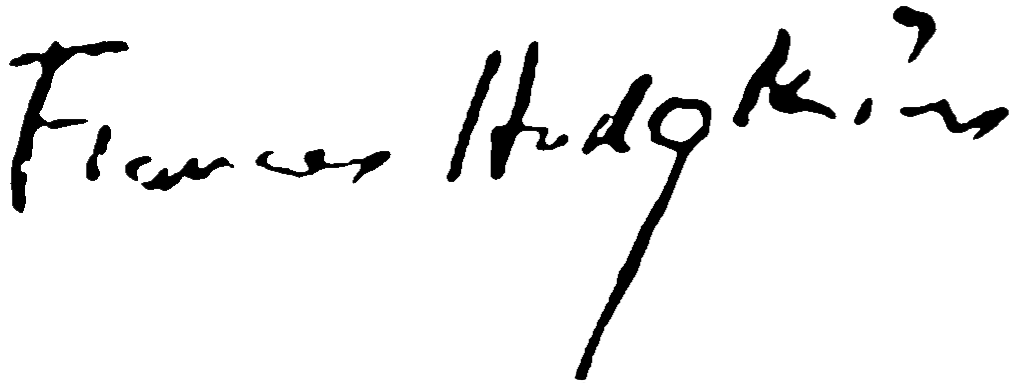-
Frances Hodgkins
Portrait of Miss Beatrice Wood, 1918
Oil on canvas, 73.5 x 73 cm
Signed lower right
To Will Field, 30 March 1918. Wharf Studio, St Ives.
My Dear Will
….The other day 3 nice girls, all from NZ, blew into the Studio - Miss Denniston of Peel Forest - Barker - ditto & Beatrice Wood from Chch, a bright fair haired girl with a fluffy dog in her arms. She wanted me to paint her a sketch of herself for her Dad - William Wood - which I did! She was awfully pleased & sent a cheque for 8gns and has dunned her Father for the balance of £12.12. ... She is a masterful, young person - of the nice sort, & I would like to adopt her…
Beatrice Wood (1889 - 1987) was born in Christchurch and educated at Rangiruru Girls' School, where her interest in painting began. She attended a finishing school in England before returning to art school in Christchurch where her tutors included Sydney Lough Thompson and Margaret Stoddart. Back in England at the outbreak of World War I, Beatrice served as a volunteer ambulance driver at the New Zealand base at Codford on Salisbury Plain. Part of her role included caring for recuperating officers, which indirectly lead to a major turning point in her personal and artistic life. Having contracted measles at Codford she went to St. Ives for a holiday, where she met and befriended Frances Hodgkins.
E. H. McCormick in his book The Expatriate describes their first meeting:
... and there was Miss Beatrice Wood who, one day in the early spring of 1918, 'blew in' to the studio at St. Ives, 'a bright fair haired girl with a fluffy dog in her arms'. She was 'a masterful young person - of the nice sort' endowed with a business sense inherited, Frances supposed, from 'that big family of miller and merchant Woods' she herself had known as young men when they visited Christchurch in her youth. In her masterful fashion, Miss Wood commissioned a portrait which was completed after three sittings and sent to New Zealand in the care of Sir Joseph Ward.
The present painting was the first of Hodgkins' oils to reach this country and Miss Wood, Frances reported, was 'awfully pleased' with the finished portrait, sent a cheque for eight guineas and 'dunned' her father for the remaining twelve.
While Miss Wood rested at St. Ives after her patriotic labours in the canteen at Codford, an intimacy sprang up between the two; 'I would like to adopt her,' wrote Frances after their first meeting.
The portrait itself is a fine example of Hodgkins' work of the period, with her intriguing use of strong, contrasted colours in the sitters face and hat, skillfully juxtaposed with the pastel tones prevalent in the painting. This early modernist technique is also evident in another of Hodgkins' important works of the period, Loveday and Anne (Tate Gallery, London). Both pictures were completed at a time when she was relatively new to oils as a medium and certainly she appears to use the oil paint almost as if it was watercolour, adding to the freshness and spontaneity of the Portrait of Miss Beatrice Wood.
The two artists remained in close contact until Beatrice's return to New Zealand. In 1921 Beatrice married Tom Seddon, son of New Zealand's former Prime Minister Richard John Seddon. As well as raising three children, Beatrice made time to pursue her artistic career, holding many 'one-man' exhibitions throughout the country. An enthusiastic gardener, many of her paintings were inspired by the camellias and rhododendrons in her own garden at Wadestown Road, Wellington. From the early 1950's a New Zealand home was not considered complete without one of Beatrice Seddon's beautiful floral studies. Beatrice also enjoyed portraying the New Zealand landscape, particularly the West Coast of the South Island and her childhood home, Canterbury. Her work also caught the eye of many visitors to this country and it is said "that there are now many homes in England, Australia, America and even India that are lovelier for one of her paintings." Lady Freyberg was one of Mrs Seddon's most enthusiastic admirers and it was she who was responsible for choosing one of Beatrice's works to adorn the Royal Suite at Government House when Princess Elizabeth visited in 1952. In 1971 Beatrice travelled to Norfolk, England to view an exhibition of Flower Paintings of the World where one of her own flower studies had been selected by the National Art Gallery to represent New Zealand.
Exhibited
London, U.K. Grosvenor Gallery. October 1918 (No. 254)
Christchurch, N.Z. Canterbury Society of Arts. 1919 (No. 34)
A Centenary Exhibition. 1969:
Dunedin, N.Z. Dunedin Public Art Gallery. April-May, 1969
Christchurch, N.Z. Robert McDougall Art Gallery. June 1969
Wellington, N.Z. National Art Gallery. July 1969
Auckland City Art Gallery, August 1969
Melbourne, A.U. National Gallery of Victoria. October 1969
London, U.K. Commonwealth Institute Gallery. February 1970
Auckland, N.Z. Jonathan Grant Galleries, The Beatrice Seddon Collection. October 2001
Provenance
Commissioned by Beatrice Seddon and painted at St. Ives in 1918.
Thence by family descent.
Reference
Frances Hodgkins Database FH0617
(completefranceshodgkins.com)
Illustrated
Ascent. Frances Hodgkins, Commemorative Issue (Caxton Press with QE II Arts Council, Christchurch 1969) p. 36
Frances Hodgkins 1869 – 1947, Queen Elizabeth Arts Council of New Zealand (Auckland 1969) p.25. No. 23
